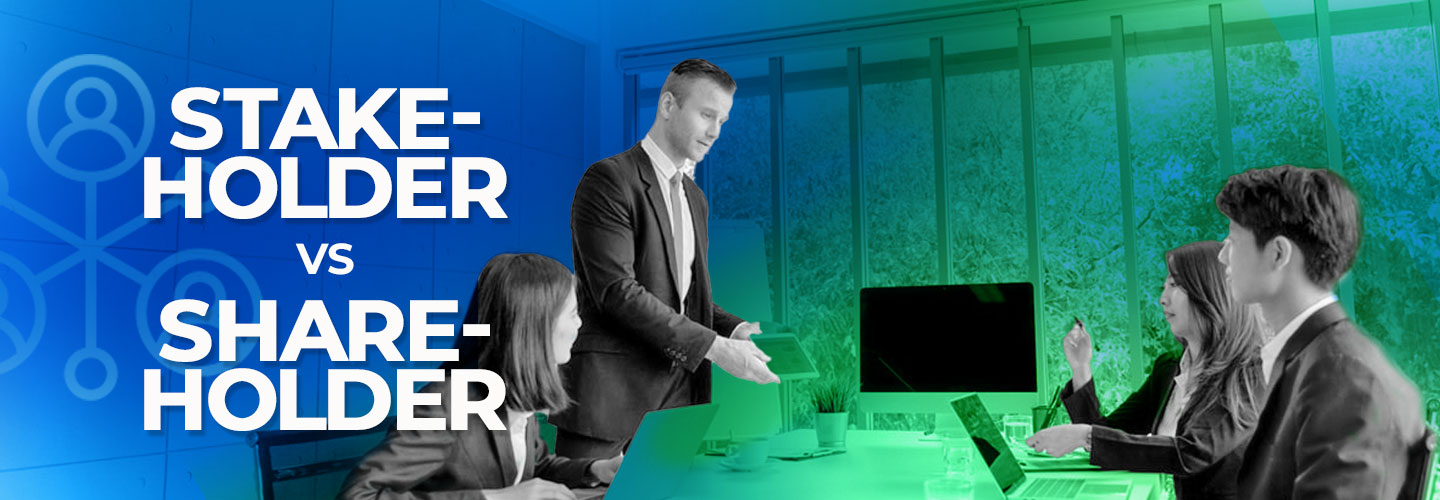Pengertian Stakeholders dan Shareholders dalam Dunia Bisnis

Orang sering sekali dipusingkan dengan istilah stakeholder dan shareholder dalam dunia bisnis. Dua istilah ini sebenarnya punya fungsi dan tugas yang berbeda. Anda yang menjalankan bisnis tentunya perlu mengetahui peran dari masing-masing istilah tersebut.
Pengertian shareholders
Shareholders adalah seseorang yang memiliki saham perusahaan. Sahamnya mewakili sebagian kecil kepemilikan dalam suatu organisasi. Sebagai menjadi pemegang saham, shareholder cenderung ingin mendapatkan keuntungan finansial terbesar dari investasi yang dijalankannya.
Itu berarti mereka mungkin tertarik pada cara kerja perusahaan pada level tinggi. Pasalnya, hal tersebut biasanya mempengaruhi harga sahamnya. Saat harga saham naik, mereka memiliki kesempatan untuk menjual saham untuk mendapatkan keuntungan.
Bergantung pada jenis saham yang dimiliki, menjadi pemegang saham memungkinkan Anda untuk mendapatkan keuntungan dari dividen. Bukan hanya itu, shareholder memberikan suara pada kebijakan perusahaan seperti merger dan akuisisi dan memilih anggota dewan direksi perusahaan.
Siapa pun yang memiliki saham di sebuah perusahaan dapat memberikan suara. Namun, pemberian suar ini sangat bergantung dengan jumlah saham yang dimiliki. Investor dengan saham besar memiliki pengaruh lebih banyak atas keseluruhan rencana strategis perusahaan
Jenis Shareholder
Bergantung pada jenis saham yang dimiliki, shareholder bisa menjadi pemegang saham biasa atau pemegang saham pilihan. Anda dapat membeli kedua jenis saham tersebut melalui akun perantara biasa, tetapi keduanya memberi keuntungan yang berbeda. Berikut keuntungan yang bisa didapatkan.
-
Shareholder saham biasa. Saham Biasa biasanya menghasilkan tingkat pengembalian yang lebih tinggi dalam jangka panjang dan memberikan sebagian kepemilikan perusahaan kepada pemegang saham. Itu berarti siapa pun yang memiliki saham biasa di sebuah perusahaan dapat memberikan suara pada kebijakan perusahaan dan memilih anggota dewan direksi. Namun, pemegang saham biasa menanggung sedikit lebih banyak risiko jika sebuah perusahaan dilikuidasi. Mereka hanya dapat mengklaim aset setelah pemegang obligasi, pemegang saham preferen, dan pemegang utang lainnya telah dibayar penuh.
-
Shareholder saham preferen. Saham preferen biasanya menghasilkan keuntungan jangka panjang yang lebih rendah tetapi memberi pemegang saham jaminan pembayaran dividen tahunan. Pemegang saham pilihan biasanya tidak dapat memberikan suara pada kebijakan atau memilih anggota dewan, sehingga mereka tidak memiliki suara untuk masa depan perusahaan. Namun, mereka memiliki lebih sedikit risiko—jika perusahaan dilikuidasi, pemegang saham pilihan dapat mengklaim aset sebelum pemangku kepentingan umum.
Mengenal Stakeholder
Seorang stakeholder adalah seseorang yang dapat mempengaruhi atau dipengaruhi oleh proyek yang sedang dikerjakan. Pemangku kepentingan bisa lebih dari sekadar anggota tim yang mengerjakan proyek bersama. Misalnya, pemegang saham dapat menjadi pemangku kepentingan proyek jika hasilnya akan berdampak pada harga saham.
Stakeholder terdapat dalam berbagai bentuk, mulai dari kontributor independen hingga eksekutif perusahaan. Kelompok orang ini juga tidak harus berada di dalam organisasi, misalnya agen eksternal yang bekerja sama. Demikian pula, pelanggan dapat menjadi pemangku kepentingan ketika preferensi mereka secara langsung mempengaruhi produk Anda.
Jenis Stakeholder
1. Stakeholder eksternal
Kelompok orang ini memiliki hubungan langsung dengan perusahaan. Mereka adalah rekan satu tim dan mitra lintas fungsi. Mereka sering kali dipekerjakan oleh perusahaan biarpun tidak selalu. Misalnya, pemegang saham adalah pemangku kepentingan internal karena mereka terikat dengan perusahaan Anda melalui saham yang mereka miliki. Dengan demikian, mereka dipengaruhi secara langsung oleh proyek yang mempengaruhi harga saham.
2. Stakeholder eksternal
Kelompok orang ini tidak memiliki hubungan langsung dengan perusahaan. Mereka seperti pelanggan, pengguna akhir, dan pemasok, hingga pada distributor. Meskipun pemangku kepentingan eksternal berada di luar organisasi, proyek yang dijalankan akan sangat bergantung pada mereka. Misalnya, meningkatkan proyek manufaktur akan membutuhkan sumber daya tambahan dari pemasok
Perbedaan utama Stakeholder dan Shareholder
Istilah pemegang saham dan pemangku kepentingan sering digunakan secara bergantian, tetapi sebenarnya sangat berbeda. Selain perbedaan definisi yang telah kami uraikan di atas, pemegang saham dan pemangku kepentingan dipisahkan oleh perbedaan utama berikut:
1. Prioritas yang berbeda
Pemegang saham dan pemangku kepentingan memiliki prioritas yang sangat berbeda. Shareholder memiliki kepentingan finansial di perusahaan karena ingin mendapatkan pengembalian terbaik atas investasinya, biasanya dalam bentuk dividen atau apresiasi saham.
Itu berarti prioritas pertama mereka biasanya untuk meningkatkan pendapatan dan harga saham secara keseluruhan. Pemegang saham perusahaan swasta dan perseorangan juga dapat bertanggung jawab atas hutang perusahaan yang memberi mereka insentif keuangan tambahan.
Di sisi lain, stakeholder berfokus pada lebih dari sekadar keuangan. Stakeholder internal ingin proyek mereka berhasil sehingga perusahaan dapat melakukannya dengan baik secara keseluruhan. Ditambah lagi, mereka ingin diperlakukan dengan baik dan maju dalam peran mereka.
Stakeholder eksternal juga ingin mendapatkan keuntungan dari proyek Anda. Namun, itu bisa berarti hal yang berbeda, seperti menerima produk hebat, mengalami layanan pelanggan yang solid, atau berpartisipasi dalam kemitraan yang saling menghormati dan saling menguntungkan.
2. Punya timeline berbeda
Stakeholder dan shareholder juga memiliki garis waktu yang berbeda untuk mencapai tujuan mereka. Shareholder akan lebih fokus pada tujuan jangka pendek karena hal itu bisa mempengaruhi nilai sahamnya.
Di sisi lain, stakeholder lebih tertarik dengan tujuan jangka panjang perusahaan. Mereka biasanya kurang fokus pada kinerja ekonomi jangka pendek dan fluktuasi harga saham. Sebaliknya, mereka ingin organisasi bekerja dengan baik secara keseluruhan.
Hal yang lebih diharapkan oleh stakeholder:
- Karyawan ingin tetap bekerja di perusahaan yang memperlakukan mereka dengan baik dan memberi mereka peluang untuk berkembang.
- Pelanggan ingin tetap menerima produk yang mereka sukai.
- Pemasok ingin mempertahankan hubungan mereka dengan perusahaan Anda dan terus mendapatkan keuntungan dari bisnis Anda dalam jangka panjang.
Alasan Stakeholder Lebih Penting
Shareholder penting bagi perusahaan. Namun, bisnis Anda harus benar-benar memprioritaskan teori pemangku kepentingan. Itu karena pemegang saham biasanya lebih mementingkan tujuan jangka pendek yang berdampak pada harga saham daripada kesehatan jangka panjang perusahaan.
Teori stakeholder bisa membantu Anda bertindak secara bertanggung jawab terhadap karyawan, pelanggan, dan mitra bisnis. Dengan memprioritaskan stakeholder terdekat, Anda dapat menciptakan lingkungan kerja yang lebih baik yang mempromosikan kesejahteraan karyawan dan kepuasan pelanggan.
Ketika tim merasa didengarkan, mereka lebih termotivasi untuk melakukan pekerjaan terbaik mereka dan membantu kesuksesan proyek. Riset menunjukkan bahwa hanya 15% pekerja yang merasa benar-benar didengarkan oleh organisasinya. Jadi, kembali lagi ke bisnis Anda mau mengedepankan yang mana.